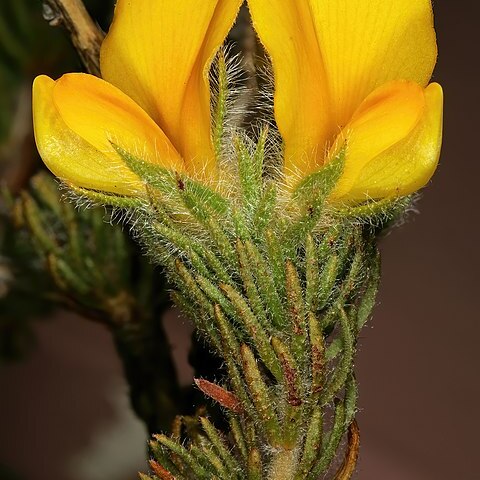A decumbent, ascending or erect, sparingly or densely branched shrub reaching a height of 0.1-1.5 m. Young branches from short-tomentose to woolly, pale yellow to reddish, and sparsely to very densely leafy. Leaves of long-shoots alternate; leaflets linear, sub-filiform or subulate, 3-15(-20) mm long, straight or often slightly incurved (sometimes recurved), from weak and flexible to rather stiff, acute or acuminate, only rarely somewhat prickly, pale to bright green (turning ferruginous, black or brown when fading in different races), glabrous or sparingly patent-pubescent, with or without distinct hair base tubercles. Inflorescence a terminal group or head of 2-6(-10) flowers radiating from almost one point, and sometimes, in addition, unifloral and situated on lateral short-shoots. Flowers medium-sized to rather large. Bracts trifoliolate, similar to the uppermost vegetative leaves, the leaflets situated on a short base; leaflets 4-16 mm long, 0.3-1.2 mm broad, with dense or sparse spreading hairs from ± distinct hair base tubercles. Pedicel 0.3-1.5 mm long, pubescent. Bracteoles simple; similar to bract leaflets, 4.5-13(-15) x (0.3-)0.4 mm. Calyx tube short-tomentose to woolly; lobes linear, lanceolate or (rarely) ovate, 3.5-13(-15) mm long, acute to acuminate, generally with ± distinct midvein and often distinct margins, clothed with variably dense, spreading hairs from ± prominent hair base tubercles; upper two lobes often much broader than the lower. Petals bright yellow, when fading or drying usually becoming reddish, in certain forms black or brown. Standard blade broadly (triangular-) obovate or circular, 10-15(-17.5) x 10-15(-16.5) mm, densely tomentose on the back, glabrous on the front, often with a short, less than 1 mm long, apical 'tip'. Wing blades narrowly ovate or elliptic, 7-13(-14) x 3-5.5(-6) mm. Keel blades lunate, (7.5-)8-12(-13) x 3.8-5.7(-6.2) mm, glabrous or in some populations ± sericeous, with ± straight to somewhat concave upper margin. Wing and keel claws attached to the staminal sheath at least at the base. Pistil: ovary pubescent or sometimes glabrous on basal lower parts. Pod (rarely seen) triangular-ovate, 5.5-6.5 x 3-3.5 mm, smooth, ± tomentose.
More
Erect or sprawling shrub, 0.1-1.5 m high. Branches short-tomentose to woolly when young, pale yellow. Leaves alternate on long-shoots. Leaflets linear-subulate, 3-15(-20) mm long, straight often slightly incurved, acute to acuminate, glabrous or softly tuberculate-hairy, pale to bright green. Inflorescences: terminal groups or heads, 2-6(-10)-flowered, radiating from almost one point. Flowers bright yellow, large; keel glabrous or silky; wing blades > 7 mm long. Calyx woolly; tube short tomentose; lobes linear to lanceolate or subglobose, tuberculate-hairy, acute to acuminate with distinct midvein. Flowering time Sept.-Feb. Pod triangular ovate, smooth, ± tomentose.
Erect or sprawling shrub or shrublet, 0.1-1.5 m. Leaves 3-foliolate, leaflets linear to awl-shaped, often slightly incurved, glabrous or softly tuberculate-hairy. Flowers in terminal heads, bright yellow, fading reddish or black or brown, wings glabrous, keel with pointed tip, glabrous, calyx woolly, lobes linear to lanceolate or rarely ovate, with a distinct midvein, tuberculate-hairy.

